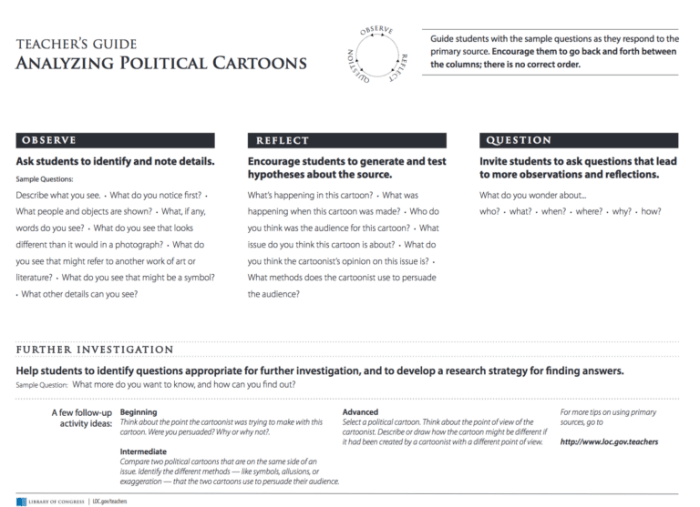Analyzing political cartoons about the role of government answer key provides a captivating lens into the complex interplay between art, politics, and public discourse. These visual commentaries, often imbued with satire, symbolism, and humor, offer a unique perspective on the powers, responsibilities, and limitations of government.
Political cartoons have a rich history, reflecting the social and political issues of their time. They employ persuasive techniques such as exaggeration, irony, and caricature to shape public opinion and influence political debate.
Political Cartoons as a Medium
Political cartoons are a unique form of political commentary that use satire, symbolism, and humor to convey messages. They often depict politicians and other public figures in exaggerated or caricatured ways to highlight their flaws or criticize their actions. Political cartoons can be powerful tools for shaping public opinion and influencing political discourse.
Cartoons use visual elements to represent complex ideas and make them more accessible to a wide audience. They can use symbols, such as the donkey for the Democratic Party or the elephant for the Republican Party, to represent political entities or ideologies.
Cartoonists often use exaggeration and caricature to create humorous or satirical effects, making their points more memorable and impactful.
Role of Government in Political Cartoons
Political cartoons often depict different perspectives on the role of government. Some cartoons portray the government as a powerful and oppressive force, while others show it as a benevolent protector of the people. Cartoonists use visual elements to represent the government’s power, influence, and responsibilities.
For example, a cartoon might depict the government as a giant hand reaching down to control the people, or as a benevolent father figure protecting the nation from harm. These visual representations help to shape public perception of the government’s role and responsibilities.
Historical Context and Social Commentary: Analyzing Political Cartoons About The Role Of Government Answer Key

Political cartoons are often created in response to specific historical events or social issues. They can reflect the political and social climate of their time and provide valuable insights into the concerns and values of the society that produced them.
For example, during the Great Depression, political cartoons often depicted the government as a bumbling and ineffective force that was unable to help the suffering masses. These cartoons reflected the widespread frustration and anger that many people felt towards the government at the time.
Persuasive Techniques in Political Cartoons

Political cartoons use a variety of persuasive techniques to make their points. These techniques include exaggeration, irony, and caricature. Exaggeration is used to make a point more humorous or memorable, while irony is used to create a sense of contrast or absurdity.
Caricature is used to create exaggerated or distorted images of public figures, often highlighting their flaws or weaknesses.
These persuasive techniques help cartoonists to make their points more effectively and to influence public opinion. By using humor, satire, and exaggeration, political cartoons can make complex political issues more accessible and understandable to a wide audience.
Comparing and Contrasting Political Cartoons

Comparing and contrasting political cartoons from different sources or time periods can provide valuable insights into the changing perceptions of the role of government. By examining how cartoonists depict the government in different contexts, we can better understand how public opinion has evolved over time.
For example, comparing political cartoons from the 19th century to those from the 21st century reveals significant changes in the way that the government is perceived. In the 19th century, the government was often seen as a powerful and oppressive force, while in the 21st century, it is more often seen as a benevolent protector of the people.
The Impact of Political Cartoons
Political cartoons can have a significant impact on political decision-making and public awareness. By raising awareness of important issues and holding politicians accountable, political cartoons can help to shape the political landscape.
For example, political cartoons played a significant role in the Watergate scandal. By highlighting the corruption and wrongdoing within the Nixon administration, political cartoons helped to turn public opinion against the president and ultimately led to his resignation.
Ethical Considerations in Political Cartooning
Political cartooning involves ethical considerations such as accuracy, fairness, and respect for public figures. While political cartoons often use satire and humor to make their points, they should not spread misinformation or perpetuate stereotypes.
Cartoonists have a responsibility to be accurate in their depictions of public figures and events. They should also be fair and avoid using offensive or demeaning language. By adhering to these ethical standards, political cartoonists can ensure that their work is both effective and responsible.
FAQ Explained
What is the significance of political cartoons?
Political cartoons provide a unique and accessible form of political commentary, allowing artists to express their views on current events and social issues in a visually engaging way.
How do political cartoons use satire and symbolism?
Political cartoons often employ satire and symbolism to convey their messages. Satire uses humor and exaggeration to criticize or ridicule political figures or policies, while symbolism allows cartoonists to represent abstract concepts or ideas through visual imagery.
What ethical considerations are involved in political cartooning?
Political cartoonists have a responsibility to be accurate, fair, and respectful in their work. They must avoid spreading misinformation or perpetuating stereotypes, and they should be mindful of the potential impact of their cartoons on public opinion.